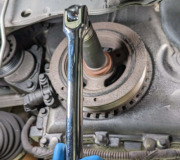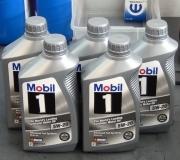"Turning over" and "cranking" are the same thing. Ice will be in the water pump. That needs to turn as the engine rotates, so if the water pump is locked up, the starter will not be able to crank the engine. The solution is to get the engine in a warm place right away. It will take longer for the freezing temperature to make its way to the center of the engine than for the more-exposed parts like the radiator and heater core. If the water in the center of the engine freezes, the car likely will not be worth repair.
The first thing to happen to the engine will be one or more core plugs will be pushed out by the ice. For this reason, they are often called "freeze plugs". That alone has the potential to save the rest of the engine block from cracking, but if this is not addressed right away, the block will crack too. There is no repair for that other than to replace the engine.
If this gets bad enough to crack the engine block, you can expect to find the radiator, coolant reservoir, and heater core to also be cracked from the expanding ice. Replacing a heater core is a real big job as it requires removing the entire dash board.
The best course of action is to pull the car into a heated garage. It can take up to two days for all the ice to melt if the garage is not real hot. A less-effective alternative is to place a large blanket over the hood, then use a portable space heater to warm the engine. Be aware if it sits too close to a plastic bumper cover, those could melt or deform. This method also does not do anything for the heater core. It might get the engine started, but no coolant will flow through the heater core so you will only get cold air from the heater.
Once warmed up or when the engine is running, look underneath for a large puddle. If the engine seems to run okay, this might just be a matter of replacing the core plugs. If there are a lot of unusual noise, and there is smoke coming out where a core plug is missing, (more than just the normal steam), have a compression test performed to check for a cracked block.
Running straight water in the cooling system is not a good idea. Antifreeze contains a lot of necessary additives including water pump lubricant, seal conditioners, and corrosion inhibitors. With just water, you'll have more water pump failures. These additives wear out in about two years which is why we replace it periodically. It is normal for the coolant to become acidic over time. That acid attacks metal parts and leads to corroded and leaking heater cores, radiators, and cylinder head gaskets. A secondary effect is water holds a lot more BTU's of heat than does antifreeze. That means it takes longer for straight water to get up to proper operating temperature than it takes for a 50/50 mixture of antifreeze and water. During that prolonged warm-up period, emissions will be higher than normal, and fuel mileage will be reduced. You will save on fuel cost what you spend on a gallon of antifreeze.
Going the other way is just as bad. One hundred percent antifreeze holds fewer BTU's of heat, so it is very inefficient at moving the heat from the engine to the radiator. Under high-stress conditions it is possible for the engine to overheat when there is no other defect. Also, straight antifreeze freezes at around minus ten degrees, so depending on your climate, it may not provide the needed protection. It is when it is mixed with water that the freeze point drops to around minus thirty five degrees.
Thursday, January 4th, 2018 AT 5:33 PM



